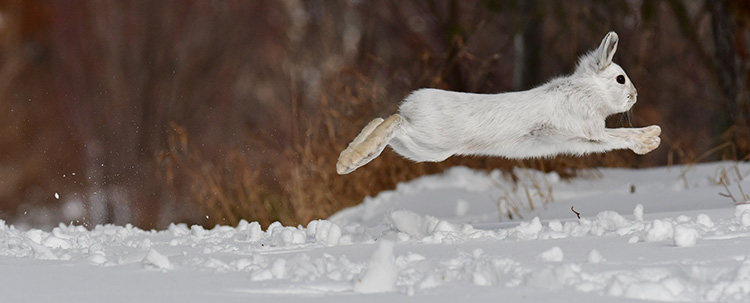Rabbits and Hares

BY MYRNA PEARMAN
It has been my good fortune to have spent, over the past few years, some quality time in the company of each of Alberta’s three native “bunny” species. All three species — which include two hares and one rabbit — have adapted well to human habitation, taking up residence in farmyards, towns, and cities across the province. Unfortunately, feral bunnies — domestic rabbits released into the wild by irresponsible pet owners — are causing serious problems in some areas of the province. Releasing domestic rabbits (or any other pets) into the wild is illegal, inhumane, unethical, and can be ecologically destructive.
Rabbits and hares belong to the Lagomorph family, a family that also includes the mountain-dwelling pika. One of the interesting characteristics of this family is that individuals produce two types of fecal pellets: dry and moist. The dry ones are expelled and left behind. The moist pellets, called cecotropes, are expelled but immediately re-ingested so remaining nutrients can be absorbed.
While all Lagomorphs share certain characteristics, such as huge hind feet, there are several traits that distinguish rabbits from hares. Baby rabbits (called bunnies) are born hairless and blind, whereas baby hares (called leverets) are born with fur, can see, and are mobile within an hour of birth. Hares tend to be larger than rabbits, and have longer hind legs and longer ears. Rabbits do not change colour over the seasons; hares change from brown in the summer to white in the winter. Rabbits tend to eat softer materials, while hares will readily dine on bark and twigs. Neither rabbits nor hares keep a customary den, but both will find or dig out shallow depressions (called forms) for resting and birthing their young. Both will hide among and under rocks, outbuildings, hollow logs, and other covered spaces. When faced with danger, rabbits tend to freeze and/or run for cover, while hares usually try to run away and outmanoeuvre their pursuer. Finally, rabbits tend to be more sociable than hares and can often be found in the company of other rabbits; hares tend to pair up only to mate (or to play, as described below).
The only true rabbit in Alberta is the mountain cottontail. Despite its name, it is not actually found in our mountains. It is restricted to the prairie regions of the province, where it can be found in areas with sufficient brushy cover. It is interesting to see them in the winter, as their brown pelage contrasts starkly against a snowy white landscape. They can be seen in many parks and urban areas, but anyone with a burning desire to see or photograph these diminutive rabbits should consider a trip to Empress, Alberta, where a healthy population thrives in and around the village.
White-tailed jackrabbits are our largest hares and are widely distributed across the prairie and parkland regions of the province. They have found cities so much to their liking that university campuses, parks, and most urban neighbourhoods (even in large cities) now support large populations. The reappearance of bobcats in Calgary is no doubt linked to an abundance of jackrabbits. These hares are nocturnal, passing the daylight hours resting in shallow depressions hidden under vegetation. They can run up to 55 km/h and can leap up to five metres!
One of Alberta’s most eloquent naturalists, the late Fred Schutz, told me a story (and wrote about his experience in his book West of the Blindman) about observing eight jackrabbits “playing” with each other one winter’s night. He was returning home on a full-moon evening with his team of horses when he happened upon a small clearing where the hares were jumping about and chasing each other, apparently just for “fun.”
Snowshoe hares are found across the province, in all but the southernmost prairie region. They are also found in cities and towns. While they are most active at night, and at dawn and dusk, they will become more active during daytime in the breeding season. Their breeding season, which in Alberta occurs from March to August, is stimulated by the appearance of new vegetation. Snowshoe hares prevent predators from following their scent to the litter by approaching and departing the nesting site in a series of large bounds, sometimes even moving at right angles to their previous direction.
Over two hundred years ago, trappers observed that there was a close relationship between the population density of snowshoe hares and their main predator, the Canada lynx. These observations were subsequently confirmed by scientific study, although it is still not fully understood what drives the snowshoe hare population cycles and their synchrony across vast areas.
Ellis Bird Farm has supported a small population of snowshoe hares for the past several years. Thanks to our patient gardener, the relationship with them has been mostly peaceful. However, a non-toxic deterrent using cayenne pepper and garlic powder is required in the spring to keep them away from the most delicious plants. Our resident great horned owls help keep the hare population in check. There is always great delight when a tiny leveret appears, and it is interesting to observe them going about their lives. They are fun to photograph, especially when their predetermined colour change is out of sync with their environment; that is, when they are still white after the snow has melted.
Myrna Pearman is the Biologist and Site Services Manager at Ellis Bird Farm (ellisbirdfarm.ca). She can be reached at mpearman@ellisbirdfarm.ca
This article originally ran in Nature Alberta Magazine - Summer 2020, Volume 50 | Number 2